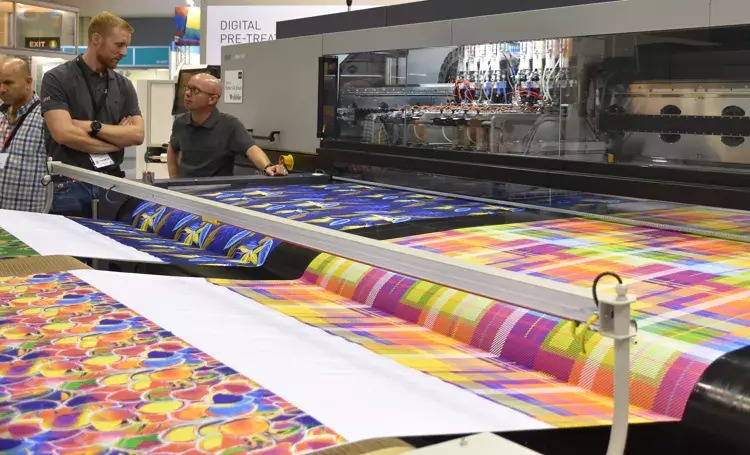Digital Printing on Textile Fabric: Digital Printing Process Step By Step
Have you ever wondered how intricate designs are printed on clothes? Although there are many types of technology available for printing clothes, digital printing is one of them. Printing intricate designs on clothing was an expensive process that required specialized equipment and skilled labor. However, since the advent of digital printing on textiles, the process of printing designs has changed. Digital printing in the textile industry is the process of printing high-quality designs directly onto clothing using digital technology. In this article, I present Digital Printing on Textile Fabric: Digital Printing Process Step By Step in below.
This digital printing in the textile fabric includes the ability to print high-resolution images on clothing. Friends, in today’s blog post, we will take a closer look at what is Digital Printing on Textiles. How does digital printing work? We’ll explore the benefits of digital printing on textiles as well as its applications and limitations. Whether you are a designer, manufacturer, or just someone interested in the textile industry, this post is going to be a significant boon for you.
What is Digital Printing on Fabric?
Digital printing is a fabric printing process in which high-quality designs are printed directly onto the fabric using digital printing technology. It is a relatively new technology from other printing techniques which has gained popularity in recent years. For digital printing on clothes, a special inkjet printer is used, which is called a printer machine. Digital printers can print high-resolution images with accurate color and detail. Fabrics with digital printing can hold onto colors for longer because in this method the ink is absorbed into the fabric, creating a durable and long-lasting print.
One of the main advantages of digital printing on textiles is that it can be used to print on a wide range of fabrics including all types of fabrics such as cotton, silk, polyester, and even synthetic fabrics. It can be used to print on both light and heavy fabrics, unlike traditional screen printing which requires separate processes for each color and fabric type. This is well known to the person operating the digital printing machine. Above we know what is digital printing, and how digital printing has gained popularity in recent years, let us now know what are the benefits of digital printing and the Digital Printing Process Step By Step below.

Digital Printing Process Step By Step on the Textile Fabric: How to do it?
1. Design Creation:
The process typically begins with the creation or selection of a digital design. Designers use graphic design software to craft intricate patterns, images, or motifs to be printed on fabric. These designs are then saved in formats compatible with digital printing machines.
2. Pre-Treatment of Fabric:
Prior to printing, the fabric undergoes pre-treatment. This step involves applying special pre-treatment solutions to the fabric, ensuring better ink absorption and color vibrancy. It helps in fixing the design onto the fabric and enhancing its durability.
3. Digital Printing Setup:
Once the fabric is pre-treated and ready, it’s fed into the digital printer. The digital printing machines operate similarly to regular inkjet printers but on a larger scale. The fabric is placed onto the printing bed or rollers, and the digital file containing the design is sent to the printer.
4. Ink Application:
The printer utilizes specialized textile inks, which are different from standard inks. These textile-specific inks are water-based or pigment-based, ensuring optimal adhesion to the fabric. The printer precisely sprays or applies the ink onto the fabric according to the design file, layer by layer.
5. Curing Process:
After printing, the fabric goes through a curing process to fix the colors permanently. Heat, steam, or a combination of both may be used to set the ink onto the fabric fibers. This step ensures the design’s longevity, wash-fastness, and resistance to fading.
6. Washing and Finishing:
Post-printing, the fabric may undergo washing to remove excess ink and any remaining pre-treatment chemicals. Washing also softens the fabric and enhances its overall feel. Finally, the fabric may undergo additional finishing processes like drying, steaming, or ironing for a polished appearance.
7. Quality Control and Inspection:
Once the fabric is printed and processed, quality control checks are performed. Inspection involves assessing color accuracy, print resolution, and overall fabric quality. Any imperfections are rectified to maintain high standards.
8. Final Printed Fabric:
The digitally printed fabric is now ready for various applications, including fashion apparel, home textiles, upholstery, accessories, and more. Designers and manufacturers can use these vibrant, custom-printed fabrics in their creations, offering unique and personalized products to consumers.
Benefits of Digital Printing on Textiles
Although there are many benefits of digital printing some of them are important which are given below:-
High-Quality Prints: High-resolution images where other printing techniques have had problems. With the help of digital printing technology, it has become easier to print high-resolution images with accurate colors and details directly onto the fabric. This means that designers can create more complex and detailed patterns than ever before, resulting in higher-quality and higher-resolution images.
Instant Change: With the help of digital printing technology, any error or mistake made at the time of printing can be rectified immediately, it is considered very good and ideal for small production companies.
Environment Friendly: Digital Printing Technics Works Environment Friendly It has acted as a revolution in printing technology. It uses less water, energy, and chemicals during digital printing on textiles, which reduces its environmental impact.
Cost-effective: Digital printing is considered a great technology for small production runs because it does not require the same setup costs as traditional printing methods. You do not need much land or space to use this printing, you can earn money by installing a machine even in a small house.
Versatility: One of the main advantages of digital printing on textiles is that it can be used to print on a wide range of fabrics including all types of fabrics such as cotton, silk, polyester, and even synthetic fabrics. It can be used to print on both light and heavy-duty fabrics, unlike traditional screen printing.
Durability: Digital prints on textiles are durable and long-lasting, and can withstand washes and wears without fading or peeling. You can wear digital printed clothes for a long time. The chances of its color fading are reduced.
Digital printing on textiles offers many benefits to designers, manufacturers, and consumers, and digital printing has revolutionized the textile industry by making it easier and more cost-effective to create high-quality custom designs.
Conclusion
Finally, digital fabric printing is an extremely innovative way to print intricate designs directly onto clothing. It has revolutionized the textile industry by making it possible to create high-quality prints on a wide range of fabrics. Digital printing on textiles offers many advantages over traditional printing methods, such as the ability to print high-resolution images with accurate colors and details, and is more environmentally friendly as it uses less water, energy, and chemicals. uses.
Digital printing on fabric has significantly transformed the textile industry, providing designers and manufacturers with a versatile and efficient method to create stunning, custom-designed fabrics. With its precision, flexibility, and sustainability, digital printing continues to shape the future of textile printing, offering endless creative possibilities.
This step-by-step guide sheds light on the intricate process behind the creation of digitally printed fabrics, showcasing the seamless integration of technology and creativity in textile production.


